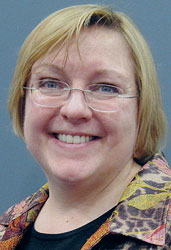The Federal Aviation Administration (FAA) has told those awaiting their slice of the GPS civil program budget that the funds are on the way.
The money, which is supposed to support that portion of the GPS program springing from the needs of civilian users, has been held up for months. In fact, as of late August — with less than 40 days left to go in the fiscal year — the money had not been transferred to either the military’s GPS Directorate or the National Coordination Office (NCO) for Space-Based Positioning, Navigation, and Timing (PNT).
By Dee Ann DivisWorking Papers explore the technical and scientific themes that underpin GNSS programs and applications. This regular column is coordinated by Prof. Dr.-Ing. Günter Hein, head of Europe’s Galileo Operations and Evolution.
By Inside GNSSSIDEBAR: Genene Fisher’s Compass Points
As Solar Cycle 24 rolls around toward its maximum peak next May, when a hundred or more sunspots may appear during the course of a single day, no single navigator stands at the helm to guide the hundreds of companies, research groups, users, and policy workers through the uncharted realm of spiking solar activity and its inevitable effects on GNSS.
By Inside GNSS One of 12 magnetograms recorded at Greenwich Observatory during the Great Geomagnetic Storm of 1859
One of 12 magnetograms recorded at Greenwich Observatory during the Great Geomagnetic Storm of 1859 1996 soccer game in the Midwest, (Rick Dikeman image)
1996 soccer game in the Midwest, (Rick Dikeman image)
 Nouméa ground station after the flood
Nouméa ground station after the flood A pencil and a coffee cup show the size of NASA’s teeny tiny PhoneSat
A pencil and a coffee cup show the size of NASA’s teeny tiny PhoneSat Bonus Hotspot: Naro Tartaruga AUV
Bonus Hotspot: Naro Tartaruga AUV
 Pacific lamprey spawning (photo by Jeremy Monroe, Fresh Waters Illustrated)
Pacific lamprey spawning (photo by Jeremy Monroe, Fresh Waters Illustrated) “Return of the Bucentaurn to the Molo on Ascension Day”, by (Giovanni Antonio Canal) Canaletto
“Return of the Bucentaurn to the Molo on Ascension Day”, by (Giovanni Antonio Canal) Canaletto The U.S. Naval Observatory Alternate Master Clock at 2nd Space Operations Squadron, Schriever AFB in Colorado. This photo was taken in January, 2006 during the addition of a leap second. The USNO master clocks control GPS timing. They are accurate to within one second every 20 million years (Satellites are so picky! Humans, on the other hand, just want to know if we’re too late for lunch) USAF photo by A1C Jason Ridder.
The U.S. Naval Observatory Alternate Master Clock at 2nd Space Operations Squadron, Schriever AFB in Colorado. This photo was taken in January, 2006 during the addition of a leap second. The USNO master clocks control GPS timing. They are accurate to within one second every 20 million years (Satellites are so picky! Humans, on the other hand, just want to know if we’re too late for lunch) USAF photo by A1C Jason Ridder.  Detail of Compass/ BeiDou2 system diagram
Detail of Compass/ BeiDou2 system diagram Hotspot 6: Beluga A300 600ST
Hotspot 6: Beluga A300 600ST

1. PAPER CUTS
Washington, Oklahoma, Ohio, Georgia, Pennsylvania
√ State transportation departments in Georgia, Pennsylvania, Oklahoma, and Ohio are printing fewer state highway maps, says the Associated Press. Washington did away with them entirely. Blame it on the double whammy of public sector budget cuts and smartphone, handheld, and in-car GPS. But there are lots of holdouts. As one Indiana man said, without a paper map, “You’re beholden to the GPS lady, you know?”
Return to main Working Papers article: "Peer-to-Peer Cooperative Positioning, Part II"
By Inside GNSSReturn to main Working Papers article: "Peer-to-Peer Cooperative Positioning, Part II"
By Inside GNSSReturn to main Working Papers article: "Peer-to-Peer Cooperative Positioning, Part II"
By Inside GNSS
Return to main Working Papers article: "Peer-to-Peer Cooperative Positioning: Part II"
By Inside GNSS
In 2003, China committed to investing €200 million (US$270 million) for the privilege of participating in the development of Europe’s Galileo program. But by 2007 it had been forced out of major decision-making because of security concerns and the collapse of the original financing plan for the program, which was to include public and private money.
By Peter GutierrezIn the 1974 Mel Brooks’ movie, Blazing Saddles, one of the characters — surrounded by his enemies — points a gun at his head and tries to escape by taking himself hostage.
As I recall, he gets away with the absurd move and survives to fight another day. That’s Hollywood!
By Dee Ann Divis
Members of Congress — who have not finished next year’s appropriations, face half a dozen major tax and program fixes set to expire, and have their own re-elections to worry about — must quickly decide how to handle a tsunami of federal budget cuts that experts say could sweep the economy back into recession.
By Dee Ann Divis
Q: What are the tradeoffs between using L1-only and L1+L2 for PPP?
A: Precise point positioning (PPP) is a technique that can compute positions with a high accuracy anywhere on the globe using a single GNSS receiver. It relies on highly accurate satellite position and clock data that can be downloaded from the International GNSS Service (IGS) or obtained in real-time from a number of service providers, using either the Internet or satellite links.
By Inside GNSS